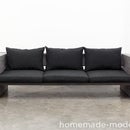Introduction: HomeMade Modern DIY Concrete Nesting Tables
I made these concrete nesting tables using nothing but Quikrete and LEGO bricks. I love how these concrete tables show the texture from the LEGO. I was skeptical about how well this idea would work, but everything went smoothly and Lego formed concrete is my new obsession.
Step 1: Supplies + Tools
LEGO Bricks
Available at Amazon
I used the classic LEGO bricks to make the mold. I raided my parent's attic to retrieve my childhood stash and purchased a few new sets. Purchasing all new bricks for this project might be a bit expensive, so I'm working on a post showing how the nightstand could be cast in sections to reduce the amount of LEGO needed.
3/4" Melamine Board
Available at the Home Depot
Melamine board is particle board with a smooth laminate surface. It's a great product for making a concrete form work. I bought a 4' by 4' sheet and had four 2 1/2" strips cut at Home Depot.
Quikrete Countertop Mix
Available at the Home Depot
I prefer the Commercial Grade Quikrete Countertop Mix for these type of projects but Quikrete 5000 will work just fine as well.
Hot Glue Gun
Available at the Home Depot
I used a hot glue gun to glue the LEGO bricks to the board. Don’t worry – the glue will peel off later.
Step 2: Layout the Mold
Build the mold up brick-by-brick. When you get to the top, place some support braces to keep the walls from bending out under the weight of the concrete. I used a single, large Lego baseplate, but this was a mistake. Use a bunch of smaller plates that will be easier to remove.
Step 3: Mix + Pour the Concrete
Mix the concrete and spoon it into the form. After you have put in about 3 inches of concrete, use a stick to push the concrete into the corners and vibrate the air bubbles out of the concrete. Repeat this process until the mold is full.
Step 4: Level + Smooth
Don’t worry about this too much because the bumpy Lego texture of the mold will be the front.
Step 5: Let the Concrete Cure
Let the concrete cure for at least 20 hours before removing the mold.
Step 6: Remove the Mold
Removing the LEGO bricks can be a bit time-consuming. Remove the a few of the upper layers and flip the block over to start removing the bottom bricks. It's easier to remove the bricks from the bottom. You can use long nose pliers to remove the bricks from the bottom, but be careful not to scratch or bend the plastic bricks.
Step 7: Clean the Legos
Most of the dried concrete flakes off the LEGO bricks. Some small pieces can be scraped or brushed off with a toothbrush. Only use cold water and mild, non-abrasive soaps to clean the bricks. If you have a mesh bag for laundering delicates, you can place the bricks in the bag and wash it in a washing machine with the water temperature set to cold. Do not use hot water or you will warp the bricks.
Step 8: Finished (+Bonus Project)!
Good luck making your own concrete nesting tables and please email or tweet photos to @benuyeda or ben@homemade-modern.com. For more DIY ideas and projects, visit us as HomeMade Modern.
BONUS PROJECT!
8-bit video games and LEGO remind me of my childhood. This mini project was an experiment in making molds for concrete inspired by 8-bit graphics.
Get Complete Visual Step-by-Step Instructions at Stellar.

First Prize in the
Concrete & Casting Contest













